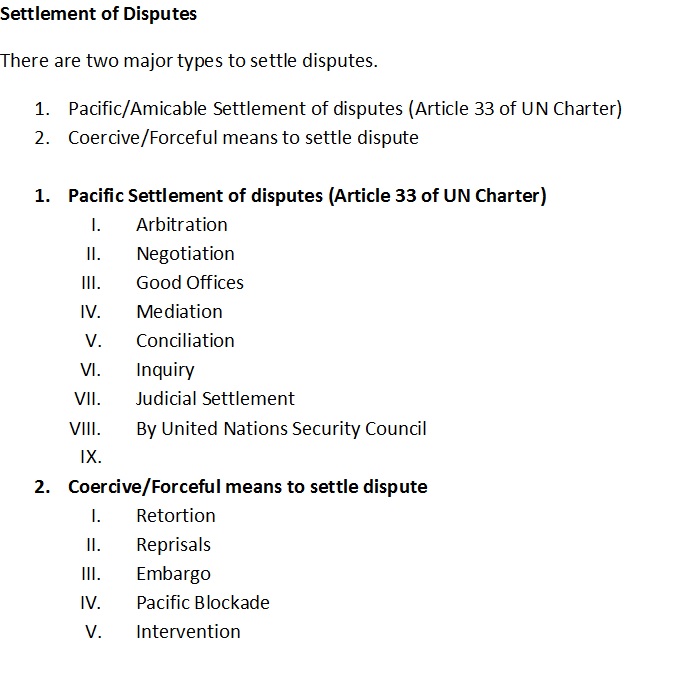
Week 3-4 Settlement of Disputes
International Law has been regarded by the international community as a means to ensure the establishment and preservation of world peace and security. The maintenance of international peace and security has always been the major purpose of the International Law. It was the basic objective behind the creation of the League of Nations in 1919 and the United Nations in 1945. Since the direct cause of war and violence is always a dispute between States, it is therefore in the interest of peace and security that disputes should be settled. Methods and procedures for the peaceful (pacific) settlement of disputes have been made available in the International Law. States have concluded a great number of multilateral treaties aiming at the peaceful settlement of their disputes and differences. The most important treaties are the 1899 Hague Convention for the Pacific Settlement of International Disputes which was revised by the Second Hague Peace Conference in 1907, and the 1928 General Act for the Pacific Settlement of Disputes which was concluded under the auspices of the League of Nations. Furthermore, there are regional agreements, such as the 1948 American Treaty on Pacific Settlement, the 1957 European Convention for the Peaceful Settlement of Disputes, and the 1964 Protocol of the Commission of Mediation and Arbitration of the Organization of African Unity. In addition to such general treaties on dispute settlement, there are many bilateral and multilateral agreements which include specific clauses related to dispute settlement. The Charter of the United Nations devotes Chapter VI to the methods and procedures for the pacific settlement of disputes. Paragraph 1 of Article 33 of the Charter states the methods for the pacific settlement of disputes as the following: negotiation, enquiry, mediation, conciliation, arbitration, judicial settlement, and resort to regional agencies or arrangements. This paragraph obliges States parties to any dispute, the continuance of which is likely to endanger the maintenance of international peace and security, to seek a solution by any of the listed methods or other peaceful means of their own choice. The methods of peaceful settlement of disputes fall into three categories: diplomatic, adjudicative, and institutional methods. Diplomatic methods involve attempts to settle disputes either by the parties themselves or with the help of other entities. Adjudicative methods involve the settlement of disputes by tribunals, either judicial or arbitral. Institutional methods involve the resort to either the United Nations or regional organizations for settlement of disputes (Collier,J. 1999).



